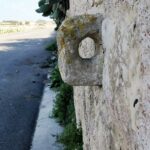When leaving the Phaeacians, “each man sat in proper order at his oarlock. They loosed the cable from the perforated stone. Once they leaned back and stirred the water with their oars” (Homer, Odyssey, 13, 78).
“Pierced stones” (τρητοῖο λίθοις, tretoi lithois) are found on ancient quays. The piercing may be horizontal or vertical. These stones have sometimes all be taken as mooring devices, but it might be of interest to have a closer look.
If you landed on this page while looking for ancient anchors, please refer to the page on ancient ships.
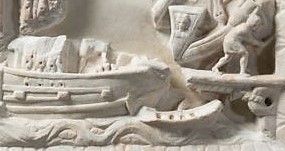
The Torlonia relief clearly shows a mooring ring with horizontal piercing and a mooring line. The unloading bridge with a man carrying an amphora is also clearly pictured.
Large mooring stones were found on the quays of the hexagonal Portus Trajanus: 2.20 x 1.10 x 0.70 m with a hole of 0.45 m.
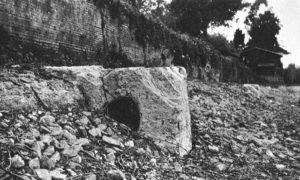
Another 2nd c. mooring ring found at Portus can be seen at the Museo delle Navi at Fiumicino.
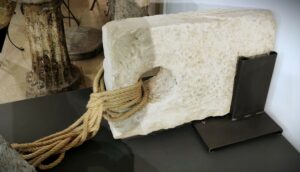
Pompei’s Porta Marina hosts a wall with many similar pierced mooring stones, but its use as a quay is uncertain.
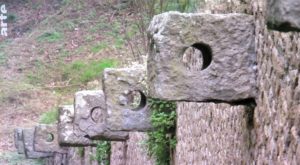
Another mooring ring with horizontal piercing can be seen on the north coast of Leptis Magna (which proves, by the way, that ships came on this side, perhaps before construction of the port inside the estuary). Note also the tenon and mortise system to attach the block inside the quay.

Mooring stones with vertical piercing are found also, e.g. on the west quay of Leptis Magna and recently at Boca do Rio (Algarve). These are fairly light structures.
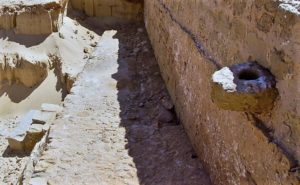
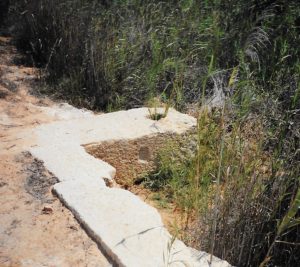
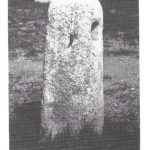
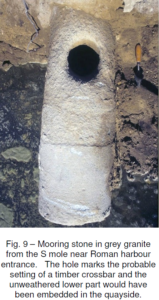
Only two cases of bollards were found, one located on the isle of Delos and one in Carthago.
.
.
.
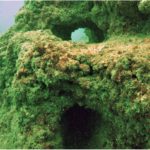
Belova’s team in Alexandria, reported a ca. 0.10 m hole near the edge of many large breakwater blocks (2 x 2 x 1 m).
These holes have probably been used for ropes, either during construction of the structure, and/or for mooring ships later on.
.
.
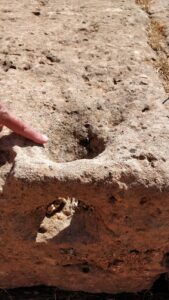
A similar case was found at Phalasarna (Crete) where a ca. 0.10 m hole was found on the edge of a quaywall block.
.
.
However, heavier structures are found also … Most goods had to be loaded/unloaded on men’s back. The heavier goods (e.g. wild animals in cages that transited through Leptis Magna on their way to Rome’s arenas) would perhaps require some kind of machinery.

According to Wikipedia “A derrick is a lifting device composed of one tower, or guyed mast (guy lines 8 on the sketch), such as a pole which is hinged freely at the bottom. It is controlled by lines (2 & 7) powered by some means such as man-hauling or motors (6), so that the pole can move in all four directions. A line runs down and over its bottom with a hook on the end, like with a crane (1 & 5). It is commonly used in docks and on board ships”.
This typically marine lifting device is not mentioned by Vitruvius who was more interested in lifting devices used for construction of buildings (Vitruvius, de Architectura, 10, 2): “All devices described above can also be used for loading and unloading ships, some upright, others laid down on pieces of timber that are easy to move. One may also place the same cables and the same pulleys on the ground in order to pull ships out of the water”
The derrick is nevertheless an obvious concept for any sailor used to handle mast, boom and topping lift.
The main interest of a derrick is that it can turn the load laterally by means of the lateral lines (7 on the sketch above). The vertical force is taken over by the vertical mast resting on a strong support. The horizontal force induced by the cantilever is taken over by two guy lines (8) placed on the land side behind the mast in order not to hinder the lateral movement of the load.
We suggest that the heavy duty pierced stones found in Aquileia and in Leptis Magna might host the foot of a derrick mast.
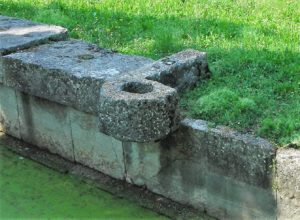

It is interesting to compare these derricks to the poles used to support the “velum” in theatres and amphitheatres (Madeleine, 2010 and 2015). They can be seen in Rome and in Nimes (France):
- 240 poles of 450 x 550 mm for Rome’s Colosseum,
- 120 poles with diameter 300 mm Nimes’ arena.

A similar, even more sophisticated, velum-pole system can be seen at the Orange theatre:
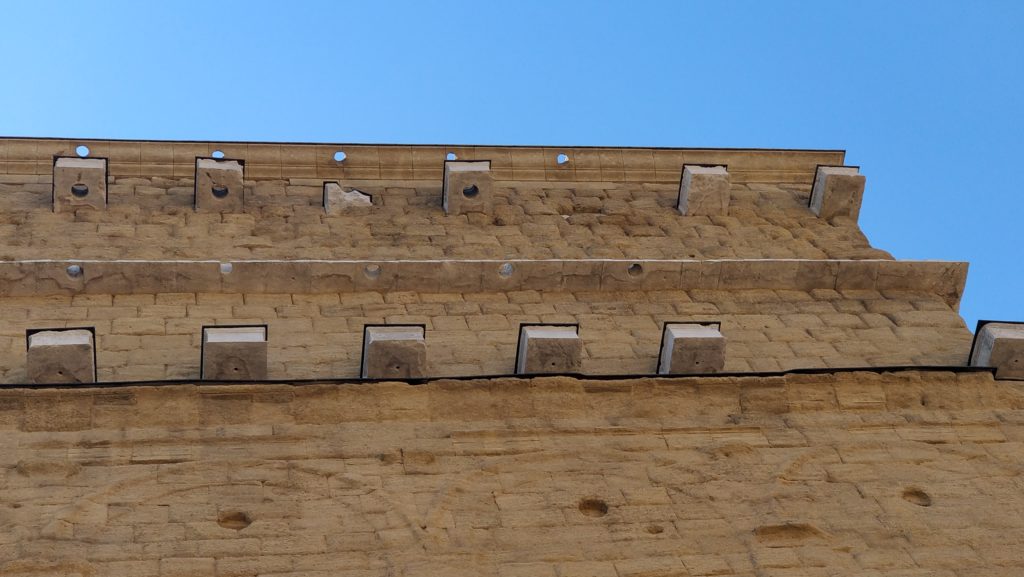
Note the three superposed holes above the pedestal stone.
(Photo A. de Graauw, 2020).
The semi-circular shape at Leptis Magna is still a bit mysterious … These pierced stones are after all perhaps just meant for some kind of wooden mooring pole, but be careful not to get your fingers and mooring lines caught between the pole and the wall …
A last group of pierced stones was found at the south anchorage of Caesarea (Sdot Yam, Israel) where two rows of 0.5 x 0.6 x 1.3 m stones, each with one 0.2-0.25 m hole, were found. This alignment is 75 m long and 5 m wide, looking very much like a jetty from the beach to some nearshore reefs. The author (Galili, 1993) assumes that the stones were used as a base for wooden piles supporting a jetty. Similar stones were found near Saintes Maries de la Mer (0.7-0.8 m stones with hole of 0.22-0.25 m diameter) (Long, 2016) and a similar stone (1.15 x 0.83 m with twin holes of 0.27 m) was found at Myndos (Dumankaya, 2015).
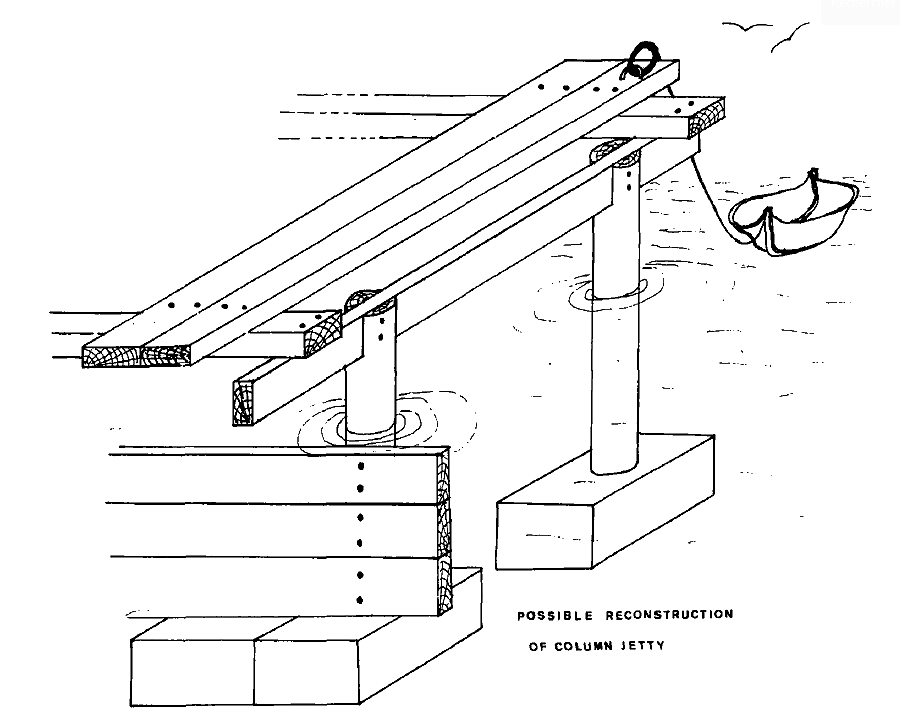
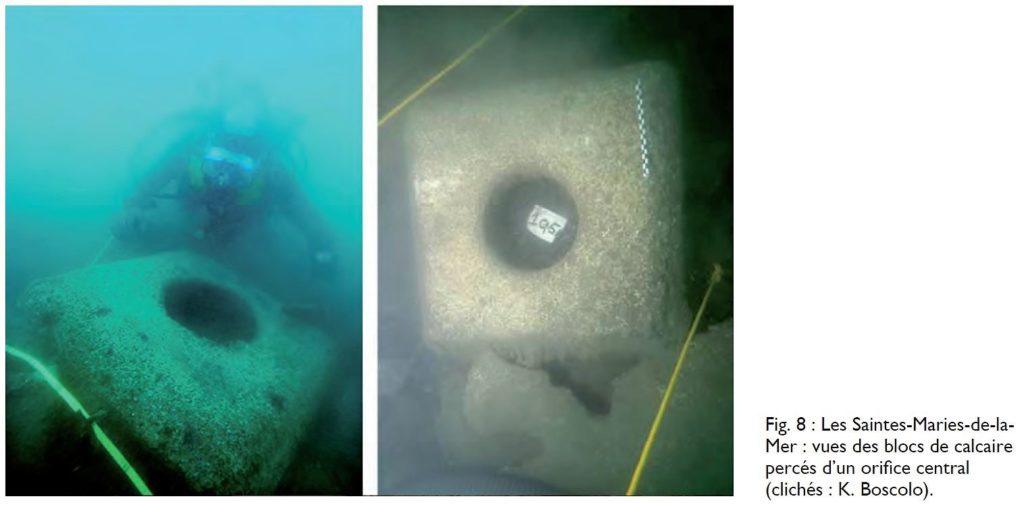
.
Pierced stones have been used at all times.
Here is a case of “mooring stone” probably meant for the horse of a knight of Malta.
.
.
References
BELOVA, G., et al., 2019, “Russian underwater archaeological mission to Alexandria, General report (2003-2015)”, Egypt and neighbouring countries 3, (p 1-31).
DUCHENE, H., and FRAISSE, P., 2001, “Le Paysage portuaire de la Délos antique”, Ecole Française d’Athènes, (192 p).
DUMANKAYA, O., 2015, “East-harbour mole at Myndos”, TINA, Sayi, N°3, (p 12-45).
GALILI, E., et al, 1993, “Underwater surveys and rescue excavations along the Israeli coast”, IJNA, 1993, 22.1, (p 61-77).
HURST, H., 2010, “Understanding Carthage as a Roman Port”, Bollettino di Archeologia on line I, Volume speciale B/B7/6, ROMA 2008 International Congress of Classical Archeaology, (p 49-68).
LONG, L., and DUPERRON, G., 2016, “Navigation et commerce dans le delta du Rhône durant l’Antiquité : bilan des recherches sur le port fluvial d’Arles et ses avant-ports maritimes”, Revue archéologique de Narbonnaise, Suppl. 44, Actes du colloque international tenu à Montpellier du 22 au 24 mai 2014, (p 199-217).
MADELEINE, S., 2010, “La restitution d’un vélum sur le théâtre de Pompée”, La technologie gréco-romaine entre restitution et reconstitution, Lire entre les lignes, mettre en les mains, Mar 2010, Caen, France, (p 43-68).
MADELEINE, S., 2015, “Essai de typologie du vélum sur les théâtres romains”, Autour des machines de Vitruve, L’ingénierie romaine : textes, archéologie et restitution, Jun 2015, Caen, France, (p 65-82).
